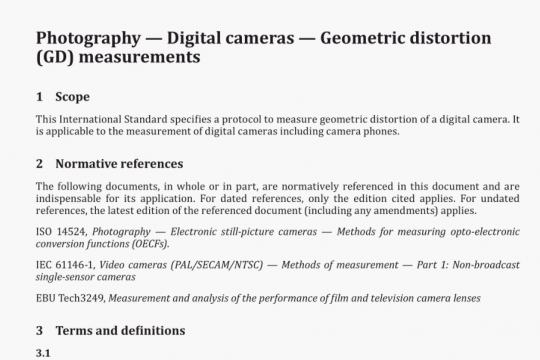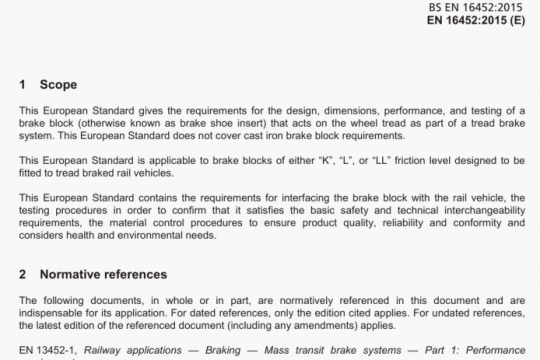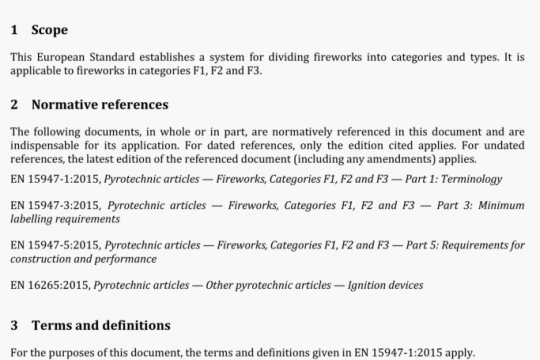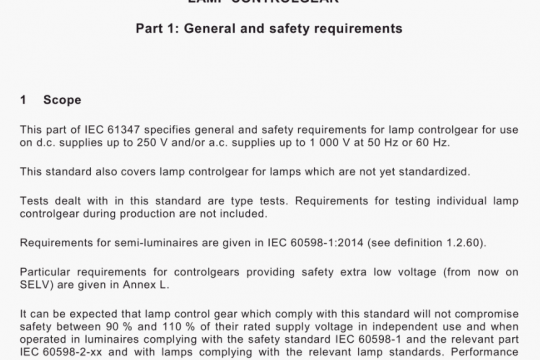BS EN 13260:2020 pdf free
BS EN 13260:2020 pdf free.Railway applications – Wheelsets and bogies – Wheelsets – Product requirements.
The requirements defined in this standard apply to cylindrical wheel seats. Most of the requirements also apply to wheelsets with conical wheel seats. Specific requirements for conical wheel seats (e.g. press-fitting curves, geometric dimensions…) are defined in the technical specification.
Some characteristics are given according to category 1 or category 2.
2 Normative references
The following documents referred to in the text constitute, for all or part of their content, requirements of this document. For dated references, only the cited edition applies. For undated references, the last edition of the reference document applies (including any amendments).
EN 13103-1, Railway applications – Wheelsets and bogies – Part 1: Design method for axles with external journals
EN 13261, Railway applications — Wheelsets and bogies — Axles — Product requirements
EN 13262, Railway applications — Wheelsets and bogies — Wheels — Product requirements
3 Terms and definitions
For the purposes of this document, the following terms and definitions apply.
ISO and IEC maintain terminology databases for standardisation, which can be accessed at the following addresses:
• IEC Electropedia: available at http://www.electropedia.org/
• ISO Online browsing platform: available at http://www.iso.org/obp
4 Product definition
4.1 Assembly of components
4.1.1 General
Before assembly, the various components of the wheelset must fulfil the geometric requirements of the specific documents that define them. In particular, the axle and wheels must be in the “ready to assemble” state defined in EN 13262 for wheels and EN 13261 for axles.
The components of the wheelset can be shrink-fitted or press-fitted to the axle. The wheels should be fitted with an oil injection hole.
The interference fits to be used must be defined by the technical specification, depending on the characteristics of the material used for this element and the forces and moments to be transmitted through the fit. This interference must be defined according to the geometric tolerances of the wheel seats whose interference values are given in 4.1.2.
In the case of shrink-fitting, the whole wheel should be heated and its temperature should not exceed 250°C. If a different heating method is used, proof must be provided that it has had no influence on the characteristics of the wheel, as defined in EN 13262.
If another fitting method is used, it must be defined in the technical specification. It must at least demonstrate that the characteristics of the axle and wheel as defined in EN 13261 and EN 13262 are not affected by the fitting. Then the mechanical resistance of the assembly (see 4.2.1) must be demonstrated and the traceability documents for each fitting must be defined to give the same type of information as that defined in E.6.
The static imbalance of the two wheels on each wheelset must be within the same diametric plane and on the same side of the axle. The static imbalance of the brake discs must be in the same plane as the wheels but on the opposite side of the axle.BS EN 13260 pdf free download.




